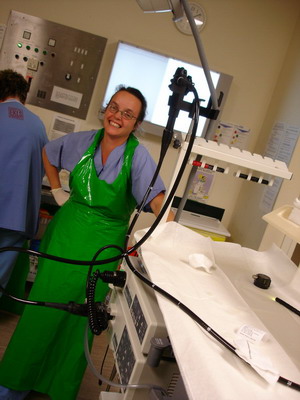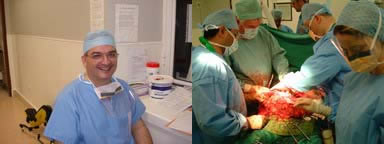Endoscopy
What is endoscopy?
Endoscopy is the medical name of the so called "camera examination" that is used to look inside your bowels. It utilizes a tiny video camera at the end of a long bendy tube (the scope) that can be steered to travel along the bowel. The scope can be made to bend in various directions, so the surgeon can move it around the bends & curves of the stomach or bowel. Fiber optics allow the transmission of the image from the tip of the scope to be shown on a large TV like screen (monitor). The image is magnified and thus allow excellent picture examination of the inside of bowels. There are 4 main types that are used in gastrointestinal surgery. These are gastroscopy, ERCP, Flexible sigmoidoscopy & Colonoscopy).
I provide a service for Colonoscopy, Flexible sigmoidoscopy & gastroscopy, but not ERCP.
Preparation for endoscopy
Patients need to fast for 6 hours before the procedure. The stomach need to be empty for gastroscopy to be successful, and also to avoid any potential for aspirating stomach contents (into the lungs) should the patient feel sick. In addition for flexible sigmoidoscopy, the patient would need to have one or two enemas 2 hours before procedure to clear the lower bowel (occasionally some patients may need full bowel preparation). For colonoscopy, patients always need full bowel preparation. This is essential to enable the surgeon to see clearly the lining of the bowel and avoid missing small lesions.
Consent & risks
Consent for the procedure is obtained from patients after explanation of the potential risks of these procedures. These include bleeding and perforation. Bleeding usually can be controlled by using diathermy (electric probe), clips or injecting special drugs into the bleeding site (adrenaline). Perforation normally means the need for emergency surgery to deal with it, but it is a rare complication.
After care
Patients are usually observed in recovery or the ward for about 1 to 2 hours after procedure (until the sedative wears off). Patients who received sedatives or pain killers can not drive or operate machinery for another 12-24 hours. They would normally need someone (spouse, friend, adult child) to stay with to stay them over the first night. Patients can normally start drinking and eating as soon as they wake up sufficiently after the procedure.
1. Colonoscopy
Colonoscopy allows examination of the whole of the colon (large bowel) and in many instances the lower end of the small bowel as well. Colonoscopy takes anywhere between 15 to 45 minutes, depending on how easy it is to negotiate the various bends in the colon and the need for any additional procedures such as removal of polyps.

Indications for colonoscopy (see also colorectal cancer screening page)
The procedure is the gold standard in looking for the cause of many of the bowel symptoms, most importantly bleeding per rectum and any change in bowel habits. It is also the preferable tool for early diagnosis of bowel cancer (screening) or lesions that can develop into bowel cancer in the future (polyps). It also shows inflamed bowel lining (colitis) and assesses the possible contribution of large bowel to abdominal pain.
A. Symptomatic patients: patients with various bowel symptoms
B. Asymptomatic patients: Beginning at age 50, you should have a screening colonoscopy every 5 years, even when there are no symptoms and no history of colorectal disease (see below), you still need to be screened. This is not yet funded on the NHS, but can be obtained privately.
C. High risk patients (at development of colorectal cancer): Personal or family history of benign colorectal polyps, colorectal cancer, breast, uterine or ovarian cancer, as well as long history (8 years or more) of ulcerative colitis or Crohn's disease. This may need to be started at age 40 or earlier.
The procedure
The surgeon will normally describe the procedure to the patient and obtain consent. Patients lie flat on the examination table and the first step is to insert a cannula (plastic needle) into one of the arm veins ready to give some medications. During colonoscopy, patients are usually give 2 or 3 medications (intravenously). These normally include a mild sedative to combat anxiety (but may also send the patient to gentle light sleep), a pain killer (to minimize the discomfort) and sometimes a bowel relaxant (to overcome bowel spasm). On rare occasions the examination is done under general anesthesia.
The patient is turned on the left side on the examining table. It is normal for the surgeon to perform a digital examination of the lower rectum before starting. The surgeon will then insert the colonoscope into the rectum and slowly guide it around the bends in the colon. The scope blows air into the colon, which inflates the colon and this allows the surgeons to guide it around the colon under vision safely. It also allows the surgeon to see better. The patient may be asked to change position occasionally to help the scope move along.
In addition to diagnosing diseases by their appearance, the surgeon can remove polyps and even early small cancers using the colonoscope. Alternatively a sample of tissue (biopsy) may be taken from inflamed tissues or from cancers. Biopsies & polyps are then sent to the pathology lab for analysis.
Colonoscopy & polyps of the Colon and Rectum
Cancers appear to develop on top of a polyp in up to 90% of the cases (10% develop in flat mucosal lining). Therefore early detection and removal of polyps has the potential to prevent up to 90% of colon and rectal cancer (in reality it could decrease it by 70-80%). Polyps may affect up to 15-30 % of the adult population. Most polyps are benign, however certain polyps may turn into cancer if not removed. That is why it is best to remove all polyps (except hyperplastic polyps which are usually biopsed only to confirm their nature).
Most small polyps are asymptomatic. Larger polyps may cause bleeding, mucus discharge or colicky abdominal pain. Polyps are removed during colonoscopy or flexible sigmoidoscopy. Large polyps may require more than one endoscopy session for complete removal. Some polyps may be too large to remove endoscopically and will require surgery instead. Once a polyp is completely removed, its recurrence is very unusual. However, up to 30% of patients with polyps will develop new polyps somewhere else.
Patients' FAQ
Why is colonoscopy better than a barium enema?
Colonoscopy has three main advantages compared to a barium enema. First, it is more accurate in detecting lesions such as polyps and small cancers (which may be missed on a barium enema). Second, it allows for removal of polyps at the same time (a therapeutic as well as diagnostic procedure) as well as taking biopsies of cancers, inflammations, strictures etc. Lastly, it is able to diagnose lesions which can not be seen on barium enemas (e.g. angiodysplaia, milder inflammation of mucosa etc.).
When should one resort to a barium enema instead?
There are few situations, when the surgeon may choose a barium enema instead
1. Assess acute colonic obstruction (obstruction makes bowel preparation - essential for colonoscopy - dangerous and makes air insufflation undesirable, as it may precipitate caecal perforation)
2. Assess acute severe lower gastrointestinal haemorrhage (acute bleeding absorbs light and makes very difficult to examine the colon properly)
3. If the aim is not to investigate bleeding, but to exclude cancer or assess progress of diverticular disease in symptomatic patients who had previous colonoscopy and failed or found the experience uncomfortable
What is caecal intubation rate (colonoscopy completion)?
Caecal intubation means reaching the caecum which is the last part of the colon that needs to be examined. It is usually possible to examine all of the colon and rectum in most patients. The reasons for incomplete examination include inexperience of the operator, presence of an obstructing lesion (narrowing or cancer), persistent fixed kinks and bends in the colon (sometimes related to previous abdominal surgery), poor bowel preparation (with faeces filling the lumen, obscuring view and making further progress unsafe) and patient discomfort and inability to tolerate the procedure. Incomplete examinations are higher in elderly populations with severe diverticular disease in long redundant colons.
Nationally colonoscopy completion rate varies from 58-100%. The consensus now is that only surgeons & endoscopists that are able to achieve 90% or more caecal intubation should continue doing colonoscopies. My latest figure is 96%
Can you miss lesions during a "complete colonoscopy"?
Yes, colonoscopy is the gold standard for detection of colonic lesions, but it is not perfect. Despite the best effort of the examining surgeon/endoscopist, there may be missed lesions in up to 5% of patients. A study of tandem (back to back) colonoscopies in the same patient by 2 examiners showed that there may be a miss rate of 6% for polyps > 1 cm [Rex, et al. Colonoscopic miss rates of adenomas determined by back to back colonoscopies. Gastroenterology. 1997;112:24-28]. In another study comparing "virtual colonoscopy" with colonoscopy, there was a 12% miss rate reported for colonoscopy [Pickhardt, et al. Computed tomographic virtual colonoscopy to screen for colorectal neoplasia in asymptomatic adults. N Engl J Med. 2003;349:2191-2200]. Most of these missed lesions are small benign and not significant. It is important however for the patient to appreciate this and report back if there are any new symptoms.
What about bowel preparation for the colonoscopy?
Bowel preparation is essential to achieve good views and to minimize the risk of missing any lesions. Many preparations are used. We tend to use "Klean Prep" or "Pico Lax". It is advisable to follow the instructions that come with the bowel preparation carefully. The end result is important as well. Initially, the stool will become liquid, but when the preparation is complete, patients should be passing almost clear watery fluid (the ideal end point to have good preparation). It is important to remember that if the preparation is inadequate, the examination will probably be incomplete and may even need to be repeated.
Patients are advised to take a low residue diet for 2-3 days before the test (avoid brown bread, vegetables and cereal, including bran). A light lunch is eaten midday on the day before the test. Thereafter patients are encouraged to drink clear fluids, but no more solid food after starting the preparation. It is reasonable to take the day off and have access to a toilet during the bowel preparation.
What about my regular medications?
Most regular medications are continued as usual (taken with a spoonful of water).
Anticoagulants such as Warfarin needs to be stopped 4-5 days before the procedure & INR checked. Patients may need to be placed on heparin pump or subcutaneous low molecular heparin such as Clexane instead. Plavix (Clopidogerol) & Aspirin may need to be stopped or continued depending on the original indications for these drugs. All constipating drugs, and in particular, iron tablets needs to be stopped for 7 days before the test.
What are the potential complications?
Complications are rare during or after colonoscopy. Some cramping pain, bloating and nausea are not uncommon during the procedure, but all resolve with the end of the procedure. Bleeding may occasionally occur after removal of polyps. The most serious potential complication is perforation of the bowel. It is more common when a polyp is removed. This is rare and affect less than 1 in 2000 patients undergoing the examination.
What happens if the colon is perforated?
This is usually immediately recognized by the surgeon/endoscopist (either by seeing small bowel loops in the free peritoneal cavity, or by excessive bloating of the patients abdomen and the occurrence of severe abdominal pain). On rare occasions a perforation may be missed initially, especially if patients has had previous surgery and there is not much free peritoneal space or in case of partial retroperitoneal perforation following a polypectomy (of a polyp on the mesenteric side).
The usual course of action is by an operation in the following few hours to suture the hole. If the perforation is recognized immediately, there is no need for a diverting stoma as the bowel has been prepared. If the perforation is missed for few hours, repair may or may not be accompanied by a proximal diverting stoma. On rare occasions, a perforation may be treated by endoscopic clipping and observation.
What am I consenting to?
You will be consented for performing the colonoscopy, taking biopsies, doing polypectomies and any other additional procedures that may appear to be essential (e.g. injection of bleeding points, tattooing of the site of lesions etc.). The consent will clearly mention that you accept the rare risk of perforation and the possible need for an emergency operation to deal with it. Finally the consent will acknowledge that there is a 5% chance of missing lesions
Coming to the hospital for the colonoscopy.
You need to allow some time before the allocated time of your test. This is usually mentioned in your letter. This is necessary for recording some admission details, change into a gown, have a cannula (small plastic needle) inserted into a vein on the back of your hand (to administer the sedative & painkiller during the procedure) and sign the consent form
Private patients need slightly longer time as they will be admitted to a private room first and later transported to the endoscopy unit (or theatres)
How long does the colonoscopy take? What happens during the procedure?
The colonoscopy usually takes about 15 to 20 minutes to complete (longer if multiple biopsies or removal of polyps is needed). During this time you will be sedated and may be asleep, but not under general anaesthetic (only used on rare occasions). You may be given additional sedation or pain killers (within safety limits) if you experience discomfort. A nurse will stay with you throughout the procedure. Your blood pressure, pulse rate, breathing and oxygen saturation will be monitored continuously during the procedure and intermittently afterwards until you wake up fully. The surgeon/endoscopist maneuver the colonoscope and examine the colon to the caecum and again while withdrawing the instrument.
What to expect after the colonoscopy?
When the colonoscopy is complete you will wait in endoscopy or theatre recovery area until you wake up sufficiently to be discharged home, accompanied by a responsible adult (or back to your room for private patients). You will not be able to drive or operate machinery for 24 hours. It is strongly recommended that you spend the night in the company of a responsible adult. It is normal for the surgeon/endoscopist to tell the patient about the result of the colonoscopy when the patient recovers from sedation.
By the time you are discharged, you should have passed most of the air used to inflate the colon. Some patients may have some residual abdominal soreness or cramping, but you should not have any real pain. It is essential that you contact the hospital immediately if there is ongoing or worsening pain (as this may denote a missed perforation).
2. Flexible Sigmoidoscopy
Flexible sigmoidoscopy is a short version of colonoscopy and allows examination of the rectum & the left side of the colon only. It uses a shorter scope (60 cm versus 160 cm scope).
It aims to examine up to the splenic flexure of the colon, but may end up any where between the sigmoid colon and the distal transverse colon, depending on circumstances (in young patients this may reach up to the splenic flexure. However in elderly patients with long redundant colon it may just about enter the descending colon).
It is used when the patient's symptoms suggest that the cause would be found on the left side. Flexible sigmoidoscopy takes 10 to 20 minutes and causes much less discomfort than colonoscopy, therefore sedation or pain killers are usually not needed, unless requested by the patient or if the patient finds the procedure too uncomfortable. This means that patient may work or drive after this examination and do not need the company of a responsible adult (unless they have chosen to have sedation).
The bowel preparation used is simpler and usually consist of 1 or 2 phosphate enemas 1-2 hours before the procedure and is usually given after arrival at the hospital.
Biopsies and polypectomies are also performed as part of flexible sigmoidoscopy. Perforation can also occur, but is even more rarer than colonoscopy. Consent issues are similar.
It should be possible to detect up to 75% of colorectal cancers and polyps using good quality flexible sigmoidoscopy. Finding any polyps (adenomatous or villous) on flexible sigmoidoscopy necessitates a complete colonoscopy on a later date, since at least 30 % of such patients will have additional polyps elsewhere in the colon.
3. Gastroscopy (OGD - Oesophago-Gastro-Duodenoscopy)
OGD (Gastroscopy) is the procedure used to examine the upper part of the gut. This includes the oesophagus (the gullet), the stomach and the duodenum (first part of the small bowel). All patients are given an anaesthetic throat spray and may also be given a mild sedative. A thinner and shorter steerable telescope similar to the colonoscope is used. It takes 5-15 minutes and is well tolerated by the majority. A significant minority would require sedation because of their strong gag reflex or anxiety.
The examination is designed to exclude or diagnose oesophageal cancer, gastric cancer, acid reflux, gastritis, duodenal ulcer and other upper GI problems such as achalasia. During the procedure, biopsies may be taken, polyps may be removed and a test for the bacterium Helicobacter Pylori (responsible for most duodenal ulcers and gastritis) is also done.
There is a very small risk of perforating the oesophagus or the stomach (very very rare). Consent takes this into account.
Patients needs to fast for 6 hours before the procedure, stop proton pump inhibitors drugs (they interfere with the test to detect Helicobacter Pylori). Other considerations in terms of recovery, implications of sedation are similar to those mentioned under colonoscopy.

